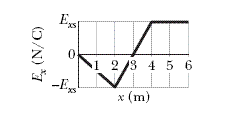A graph of the x component of the electric field as a function of x in a region of space is shown in the figure. The scale of the vertical axis is set by Exs = 20.0 N/C. The y andz components of the electric field are zero in this region. If the electric potential at the origin is 17 V. (a) what is the electric potential at x = 2.0 m, (b) what is the greatest positive value of the electric potential for points on the x axis for which 0 <= x <= 6.0 m, and (c) for what value of x is the electric potential zero? Est Ę (N/C) -Ex 1 2 3 4 5 6 x (m)
A graph of the x component of the electric field as a function of x in a region of space is shown in the figure. The scale of the vertical axis is set by Exs = 20.0 N/C. The y andz components of the electric field are zero in this region. If the electric potential at the origin is 17 V. (a) what is the electric potential at x = 2.0 m, (b) what is the greatest positive value of the electric potential for points on the x axis for which 0 <= x <= 6.0 m, and (c) for what value of x is the electric potential zero? Est Ę (N/C) -Ex 1 2 3 4 5 6 x (m)
College Physics
11th Edition
ISBN:9781305952300
Author:Raymond A. Serway, Chris Vuille
Publisher:Raymond A. Serway, Chris Vuille
Chapter1: Units, Trigonometry. And Vectors
Section: Chapter Questions
Problem 1CQ: Estimate the order of magnitude of the length, in meters, of each of the following; (a) a mouse, (b)...
Related questions
Question

Transcribed Image Text:A graph of the x component of the electric field as a function of x in a region of space is shown in the figure. The scale of the vertical axis is set by \(E_{xs} = 20.0 \, \text{N/C}\). The y and z components of the electric field are zero in this region. If the electric potential at the origin is 17 V, answer the following:
(a) What is the electric potential at \(x = 2.0 \, \text{m}\)?
(b) What is the greatest positive value of the electric potential for points on the x-axis for which \(0 \leq x \leq 6.0 \, \text{m}\)?
(c) For what value of x is the electric potential zero?
**Graph Explanation:**
- The graph is a plot of \(E_x\) (N/C, vertical axis) versus \(x\) (m, horizontal axis).
- The vertical axis is labeled with increments from \(-E_{xs}\) to \(E_{xs}\).
- The graph starts from \((0,0)\), dips at around \(x=3\), and then rises back to zero at \(x=4\), beyond which it becomes positive and constant.
**Questions with Input Boxes:**
- (a) Input number with a unit selection
- (b) Input number with a unit selection
- (c) Input number with a unit selection
Expert Solution
Step 1: Determine the given data:

Step by step
Solved in 5 steps with 9 images

Knowledge Booster
Learn more about
Need a deep-dive on the concept behind this application? Look no further. Learn more about this topic, physics and related others by exploring similar questions and additional content below.Recommended textbooks for you

College Physics
Physics
ISBN:
9781305952300
Author:
Raymond A. Serway, Chris Vuille
Publisher:
Cengage Learning

University Physics (14th Edition)
Physics
ISBN:
9780133969290
Author:
Hugh D. Young, Roger A. Freedman
Publisher:
PEARSON

Introduction To Quantum Mechanics
Physics
ISBN:
9781107189638
Author:
Griffiths, David J., Schroeter, Darrell F.
Publisher:
Cambridge University Press

College Physics
Physics
ISBN:
9781305952300
Author:
Raymond A. Serway, Chris Vuille
Publisher:
Cengage Learning

University Physics (14th Edition)
Physics
ISBN:
9780133969290
Author:
Hugh D. Young, Roger A. Freedman
Publisher:
PEARSON

Introduction To Quantum Mechanics
Physics
ISBN:
9781107189638
Author:
Griffiths, David J., Schroeter, Darrell F.
Publisher:
Cambridge University Press

Physics for Scientists and Engineers
Physics
ISBN:
9781337553278
Author:
Raymond A. Serway, John W. Jewett
Publisher:
Cengage Learning

Lecture- Tutorials for Introductory Astronomy
Physics
ISBN:
9780321820464
Author:
Edward E. Prather, Tim P. Slater, Jeff P. Adams, Gina Brissenden
Publisher:
Addison-Wesley

College Physics: A Strategic Approach (4th Editio…
Physics
ISBN:
9780134609034
Author:
Randall D. Knight (Professor Emeritus), Brian Jones, Stuart Field
Publisher:
PEARSON